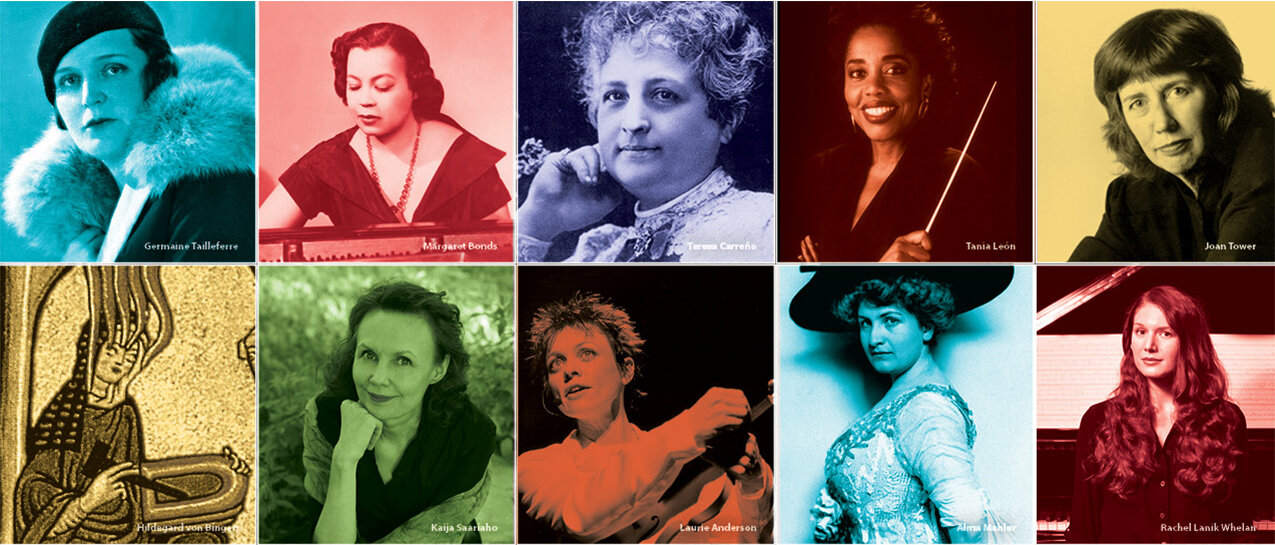Belonging in all Places Music Is Being Made




by Rachel Lanik Whelan
Contributing Author
A Little History and Context
It seems too obvious to say aloud: women and non-white people have been creating, writing, and making music throughout history and today, yet most orchestral seasons focus on the music of dead White men. When I started composing music in high school, I began to notice how infrequently the names on concert programs looked like mine, how the dates next to these names indicated years of centuries past. As with most professions before the mid-20th century, women and people of color in Western society were not provided the opportunity to acquire skills that might allow them to have self-sustaining careers as composers. The disproportionate number of white male composers speaks more to the values of society throughout history than it does to the quality of music written by the women and composers of color.
We’re fortunate to live in an era where anyone can be encouraged to compose and perform music as a career, but programming efforts haven’t yet caught up with the wide range of contemporary music available. In the last ten years there have been increased efforts to diversity programs to include works by historically underrepresented composers. The Institute for Composer Diversity published an analysis of 120 orchestras and their concert programming of the 2019-2020 season. The data showed that 8% of the music programmed was by women composers and 11% of the music programmed was by composers from underrepresented racial, ethnic, and cultural heritages. The study also found that the most performed composers of the 2019-2020 concert season are all white European men, most of whom have been dead for over a century. A similar statistic is true for programming at Spartanburg Philharmonic, with the most performed composers being Brahms, Mozart, John Williams, Tchaikovsky, and Beethoven.
The music of these composers is wonderful; we’re captivated by the power, drama, and emotion of these classic works. But doesn’t an audience in upstate South Carolina have more in common with living American composers, women composers, and Black composers than they do with dead German composers? Don’t we feel more connected to the music when the composers and performers are expressing ideas which relate to us more personally?
Spartanburg Philharmonic History
Because the Spartanburg Philharmonic was borne from the Converse College orchestra, an ensemble within an all-women’s school, the Philharmonic has always had relatively equal representation on the stage. Personnel rosters dating back to 1968 and archived programs indicate that the Spartanburg Philharmonic had about a 50/50 split of men and women performing, and they have always had a woman as concertmaster. Guest artists have similarly been equally invited male and female.
During her tenure as Music Director of the Spartanburg Philharmonic conductor Sarah Ioannides was a presence onstage and in her programming choices. Her commitment to creative and inclusive programming furthered the mission of the Spartanburg Philharmonic to educate, enrich, and inspire through music of today by composers of today. Under her leadership, award-winning Kati Agócs served as Composer in Residence for the 2009-2010 season.
The music of female composers has been incorporated into programming choices as early as 1935 with South Carolina-born Lily Strickland’s “Blue Ridge Idylls.” Florence Price and Fanny Mendelssohn are the most performed female composers by the Spartanburg Philharmonic, but music by local and regional composers Dosia McKay, Carrie Leigh Page, and Caroline Shaw have delighted Spartanburg Philharmonic audiences in recent years. Simple steps like seeing women on the podium, on the stage, and on the program allow young women to envision their future in these positions.
2020-21 Season Highlights
The February 20, 2021 concert will feature Jesse Montgomery’s exuberant and energetic “Starburst” and a movement from Florence Price’s magnificent “String Quartet in G.” Montgomery’s “Starburst” shimmers with brightness, passing sparkling and sly melodies throughout down the ensemble. Price’s Andante moderato from String Quartet in G alternates a nostalgic lyrical melody with a bluesy and chromatic one.
The March 20, 2021 concert features a work by composer-creative Jocelyn Chambers. This 24 year old Los Angeles-based composer is equally comfortable writing for film, television, and concert stages. Her work “Study in Grieg” evokes forms, melodies, and harmonies of the Romantic era.
On their February 7 concert, the Junior Youth Orchestra will be performing educational pieces by Soon Hee Newbold and Debra Baker Monday, a composer whose music they performed in last fall’s outdoor concert as well.
Looking Forward
Every orchestra in America can improve their programming to be more equitable and inclusive. Creative programming does not need to rely on the same 20 masterworks, delightful as these pieces may be. More importantly, through diverse and inclusive music programming symphony orchestras can better relate to the communities they serve. In 2018, there were 1.07 times more Black or African American residents in Spartanburg, SC than any other race or ethnicity. Two poignant lines from Spartanburg Philharmonic’s June 5, 2020 statement against systemic racism highlight the ways in which the Spartanburg Philharmonic seeks to better understand, empathize with, and uplift the Black community through music stood out to me:
The Spartanburg Philharmonic continues to be committed to improving inclusivity and diversity by making persons of color an integral part of our leadership, our orchestra, as well as the music we play.
We stand in support of the BIPOC artists and musicians of our community. We pledge to continue to seek meaningful ways to magnify their work and contributions to our community.
The inclusion of works this season by Black female composers Jesse Montgomery, Florence Price, and Jocelyn Chambers is a demonstration of this commitment. Continued efforts towards inclusion, accessibility, and amplification will further this commitment. Representation is one of the easiest ways an organization can demonstrate a commitment to connecting and empowering their community. The Spartanburg Philharmonic’s commitment to diverse representation in programming and on the stage allows them to educate, empower, and amplify voices in Classical music which deserve to be heard.
___________________
The orchestras surveyed were the: Berliner Philharmoniker, Vienna Philharmoniker, London Symphony Orchestra, Chicago Symphony Orchestra, Los Angeles Philharmonic, Bavarian Radio Symphony Orchestra, Cleveland Orchestra, Dresden Staatskapelle, Boston Symphony Orchestra, New York Philharmonic, London Philharmonic Orchestra, Royal Concertgebouw, Vancouver Symphony Orchestra, Sydney Symphony Orchestra, and São Paulo Symphony Orchestra.
Statistical information provided by the Donne Foundation
Rachel Lanik Whelan is a contributing author to the Spartanburg Philharmonic and a composer herself. As a composer, Rachel writes lyrical, honest, narrative-driven music. Much of her work is written in collaboration with living poets; she has had the pleasure of setting the words of Paul L. Thomas, Katherine Cooley, and Jehanne Dubrow. She is currently a PhD student and teaching fellow in composition at the University of North Texas in Denton, TX. Her current research and compositions involve exploring emotions and characters in music for voice.
